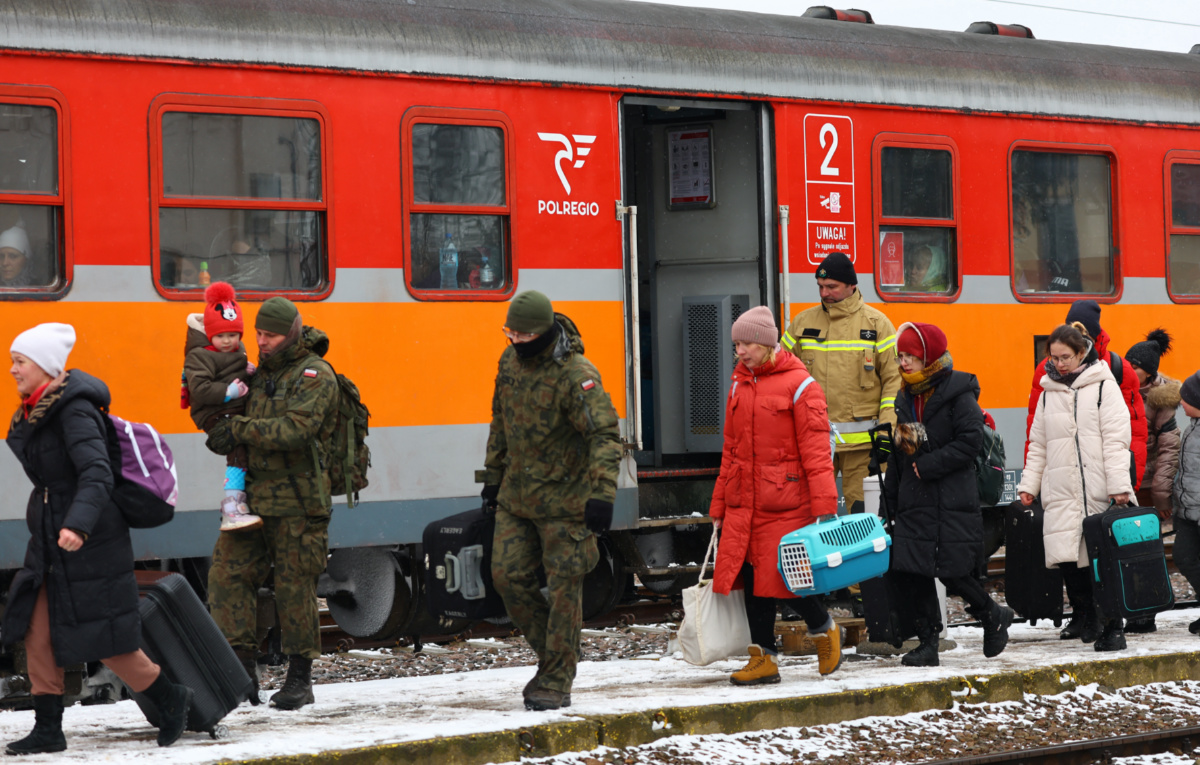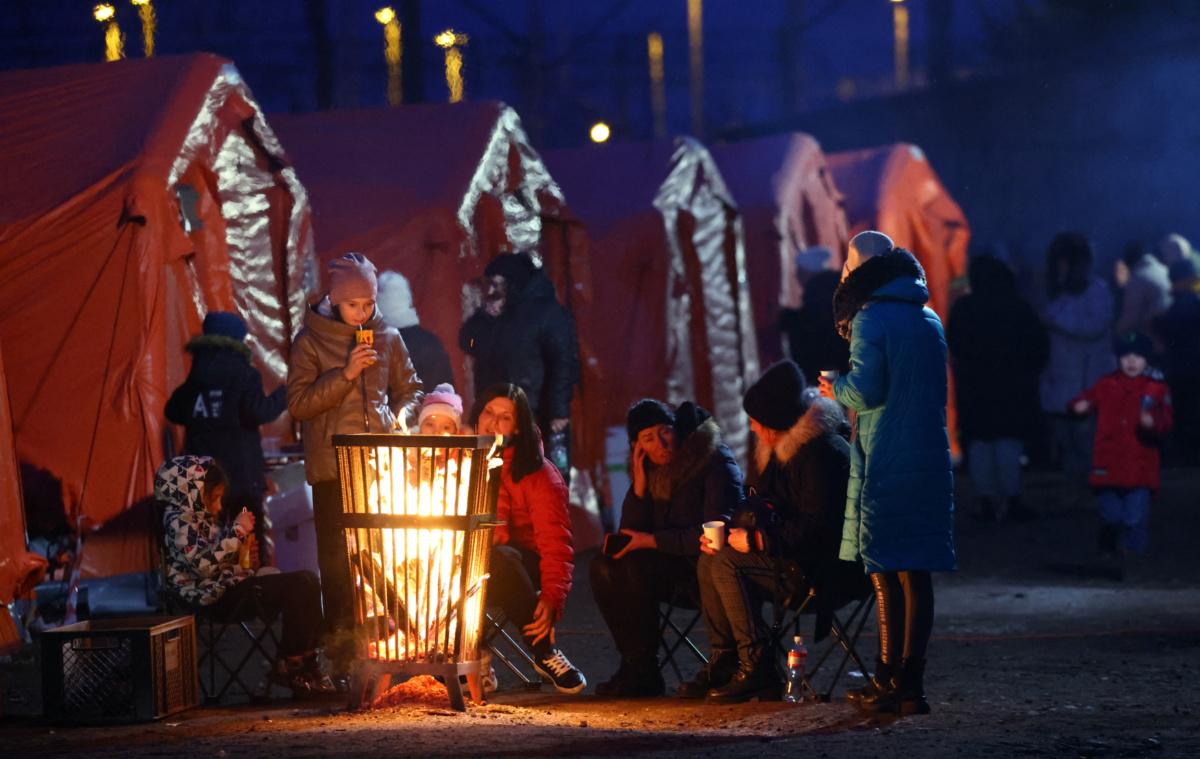Przemsyl, Poland/Isaccea, Romania
Reuters
Thousands more Ukrainian refugees fled to central and eastern Europe on Wednesday, many with no contacts and nowhere to go, as host countries scrambled to accommodate them.
The number of refugees has probably reached 2.1 to 2.2 million since Russia invaded Ukraine on 24th February, the head of the UN refugee agency, UNHCR, Filippo Grandi, said.
Most are women and children, as able-bodied men have been ordered by the Kyiv government to stay home to fight.

Polish army soldiers and volunteers assist people board a train to Krakow following crossing the border from Ukraine to Poland, after fleeing the Russian invasion of Ukraine, at the border checkpoint in Medyka, Poland, on 9th March. PICTURE: Reuters/Fabrizio Bensch
So far, most refugees have gone to relatives, friends or contacts in the Ukrainian diaspora rather than to reception centres being set up by authorities, Grandi said.
MORE THAN A MILLION CHILDREN FLED UKRAINE SINCE START OF RUSSIAN INVASION – UNICEF
More than a million children have fled Ukraine to neighboring countries in the less than two weeks since Russia started its invasion of Ukraine, the head of the United Nations Children’s Fund (UNICEF), said on Wednesday.
At least 37 children had been killed and 50 injured, Executive Director Catherine Russell said in a statement.
Russell said that she was “horrified” by the reported attack on a children’s hospital in the Ukrainian city of Mariupol, where officials said a Russian air strike buried patients under rubble despite an agreed ceasefire.
“This attack, if confirmed, underscores the horrific toll this war is exacting on Ukraine’s children and families,” Russell said.
– HUMEYRA PAMUK, Washington DC, US/Reuters
“This is the best way for them to feel welcomed, to feel in a familiar environment and also have less burden on public services, frankly, which is very important for these countries,” he said.
But this was likely to change as more refugees arrive and more will need to stay in reception centres, Grandi said.
“We need to be realistic and we need to plan for that.”
Some signs of that trend were appearing at Przemysl, a town near Poland’s busiest border crossing that has become a transit hub for refugees.
“At the start, about 90 to 95 per cent were people who had a place to go, now there’s many more people looking for a place to go and where someone will take care of them,” Mayor Wojciech Bakun told reporters, speaking in front of the train station where refugees arrive from Ukraine. “They don’t have friends or relatives.”
Alina Kondrashova, 33, a doctor from Krivoy Rog in Ukraine, who arrived in Przemysl on Wednesday with her three-year-old, mother, sister and her sister’s baby, was hoping to travel on to Estonia by bus.
“We don’t have family there, but my mother was born there during Soviet times and there’s a place to stay,” she told Reuters at the train station, where the temperature was -1 degree Celsius and snow was falling.
Another arrival at the station was Viktor from Makariv near Kyiv, a 64-year-old school security guard who said he did not know anyone in Poland.
“I’d like to stay here in Poland and return when all of this ends,” he said.
“We were very scared”
Some spoke of harrowing experiences as they fled their country.
“We were hiding with my family in the basement and [Russian forces] bombed so hard that sand was falling from the ceiling…nd we were very scared,” said Irina Mihalenka, who left an area north-east of the Black Sea port of Odessa before arriving in Romania.
“When we were walking, a bridge was blown up. And when we crossed over the wreckage…because there was no other way out, there were corpses of Russian people [soldiers] lying there.”

People warm up at a bonfire while waiting to board a train to Krakow after crossing the border from Ukraine to Poland, following the Russian invasion of Ukraine, at the border checkpoint in Medyka, Poland, on 9th March. PICTURE: Reuters/Fabrizio Bensch
Authorities in the Romanian capital Bucharest opened two centres for Ukrainian children to play and do activities before they move on elsewhere with their families.
At the Siret border crossing, refugees continued to cross from Ukraine on foot and by car, most carrying backpacks and dragging suitcases. Some carried pets.
They are welcomed by volunteers offering hot drinks, food and a smile. Travelling by train remains free for Ukrainian refugees.
Further south, dozens of women and children crossed the Danube by barge from Orlivka in Ukraine to Isaccea in Romania, huddling in winter coats against the bitter wind.
Romanian firefighters helped them carry children and luggage to shore and into orange tents put up as shelter.
We rely on our readers to fund Sight's work - become a financial supporter today!
For more information, head to our Subscriber's page.
In Warsaw, Mayor Rafal Trzaskowski met with leaders of non-governmental organisations to find ways to meet what they described as the biggest humanitarian crisis the city had faced since the end of World War Two.
Back in Przemysl, signs were put up in shelters in Ukrainian, Russian, Polish and English encouraging refugees to think safety when taking a lift. “Take a selfie with the driver – if they refuse, don’t go with them” and “Avoid tired drivers”, some read.
Across central Europe, memories of Moscow’s dominance after World War II run deep, heightened by outrage at Russia’s invasion of Ukraine.
Moscow calls its action a “special military operation” to disarm its neighbour and dislodge leaders it calls “neo-Nazis”. Kyiv and its Western allies dismiss that as a baseless pretext for an unprovoked war against a democratic country of 44 million people.
The UNHCR is planning a cash programme for refugees that could help them pay rent in private accommodation. “It will start hopefully by this week in Poland,” Grandi said. “We will try to do this to complement what governments are doing.”
The United Nations’ plans are based on four million refugees arriving but Grandi said the number would likely have to be revised upwards.
More than 1.3 million people have crossed into Poland since the war began, while nearly 320,000 have crossed into Romania – more than half entering via non-EU member Moldova – and 153,000 having entered Slovakia, officials said.
– Additional reporting by BRANKO FILIPOVIC in Siret, Romania, ANNA RINGSTROM in Stockholm, Sweden, GWLADYS FOUCHE in Oslo, Norway, ANNA WLODARCZAK-SEMCZUK and PAWEL FLORKIEWICZ in Warsaw, Poland, JASON HOVET in Prague, Czech Republic, and LUIZA ILIE in Bucharest, Romania.






